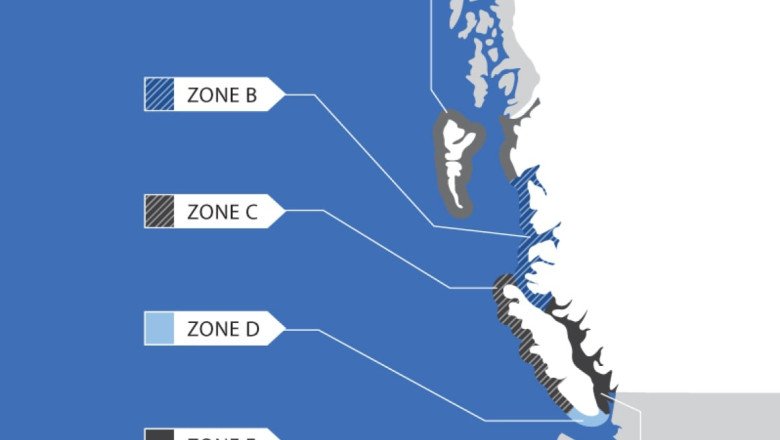
views
THE LATEST:
Residents have been asked to avoid shorelines and beaches after a tsunami advisory was issued for multiple parts of the B.C. coast following a large earthquake in the Pacific basin near Kamchatka, Russia, on Tuesday afternoon.
The U.S.-based National Tsunami Warning Centre says there was a magnitude 8.8 earthquake, with B.C. officials saying it occurred around 135 kilometres southeast of the Russian city of Petropavlovsk around 4:25 p.m. PT.
A tsunami advisory, upgraded from an earlier watch, has been issued for B.C.’s north and central coasts, including Kitimat and Bella Coola, Haida Gwaii and the west and northeast coasts of Vancouver Island.
It also spans the Juan de Fuca Strait from Jordan River to Greater Victoria, including the Saanich Peninsula.
Emergency officials say that tsunami waves arrive in a series and the first of them may not be the biggest, with tsunami activity expected in some regions of coastal B.C. late Tuesday night.
A tsunami advisory means residents should move away from the ocean and stay alert for more instructions from officials. They say the current advisory means strong currents are likely in coastal regions.
“Significant inundation is not expected for areas under an advisory, but coastal zones may be at risk due to strong currents,” reads an Emergency Info B.C. advisory.
For Tsunami Notification Zones A, B, C, & D currently under Tsunami Advisory: <br>• Stay out of the water. DO NOT go to the shore to observe currents or waves<br>• Avoid low-lying coastal areas, harbors, marinas & beaches until emergency officials say it is safe<br>• Monitor for… <a href=”https://t.co/rMo16swgLj”>https://t.co/rMo16swgLj</a> <a href=”https://t.co/9siotR5snt”>pic.twitter.com/9siotR5snt</a>
—@EmergencyInfoBC
The advisory adds strong waves and currents could drown or injure people who are in the water, and currents at beaches, harbours, marinas or bays could be especially dangerous.
It had earlier advised boat operators in areas under a tsunami watch to move their boats out to sea to a depth of at least 180 feet (55 metres) if time and conditions permit, and avoid shallow water and inlets if they are already at sea.
A tsunami warning, which is the highest level, means move away from the water immediately.
“So that’s what’s taking place right now in Kamchatka,” said John Cassidy, a seismologist with Natural Resources Canada.
He added Tuesday’s earthquake was the type of seismic movement that was most likely to generate a tsunami, and there was already confirmation of a tsunami being generated in the local region of Kamchatka.
“Those waves can travel across the Pacific…. They can travel a long way when they’re out in the open ocean,” he told Jason D’Souza, host of CBC’s All Points West, just before 6 p.m. PT on Tuesday.
“The tsunami waves travel at about the same speed as a jet,” he added.
Massive earthquake in the Pacific Ocean prompts a tsunami watch for parts of B.C.
CBC’s Darius Mahdavi reports on a massive earthquake in the Pacific Ocean which has led to a tsunami watch in parts of B.C.
The District of Tofino on the west coast of Vancouver Island said in an emergency notification around 7 p.m. PT that people shouldn’t go to the shore to observe the waves, and later told CBC News in an email that it had closed all beaches until further notice.
It says the National Tsunami Warning Center has indicated tsunami activity would reach Tofino around 11:30 p.m. PT on Tuesday, with a wave height of around one foot (0.3 metres).
Emergency Info B.C. says Langara Island, off the coast of Haida Gwaii, will see tsunami waves around 10:05 p.m. PT, but the wave height is expected to be less than 0.3 metres.
If the magnitude of 8.8 is confirmed, the earthquake would be among the top 10 strongest earthquakes recorded since 1900, according to the U.S. Geological Survey.
It would be the strongest earthquake since the devastating 2011 earthquake that struck near the Tōhoku region of Japan, which had a magnitude of 9.0 and triggered a tsunami wave more than 40 metres high.
“It’s a larger earthquake than we’ve seen,… in my lifetime anyway, that’s that close [and] could potentially affect our B.C. coast,” said Elmer Frank, chief councillor of the Tla-o-qui-aht First Nation, whose traditional territories encompass Tofino and Ucluelet on Vancouver Island.
Frank said Tuesday’s earthquake and tsunami scare is a reminder for his community to keep up on emergency drills and preparedness.
The U.S. Geological Survey, in an updated measurement on Tuesday evening, said the quake hit at a depth of 20.7 kilometres.
A tsunami warning has been issued for the U.S. state of Hawaii, with the National Weather Service’s Pacific Tsunami Warning Center saying a tsunami from the quake had been generated that could cause damage along the coastlines of all the Hawaiian islands.
“Urgent action should be taken to protect lives and property,” the warning stated. The first waves were expected around 7 p.m. local time.
A tsunami warning is also in place for parts of the Alaska Aleutian Islands.
Japan’s meteorological agency has issued a tsunami alert for Japan’s Pacific coast, upgrading an earlier advisory that warned of a tsunami of up to three metres across the Pacific coast of Japan.
https://wol.com/tsunami-watch-upgraded-to-advisory-for-much-of-b-c-coast-after-major-earthquake-near-russia/























Comments
0 comment